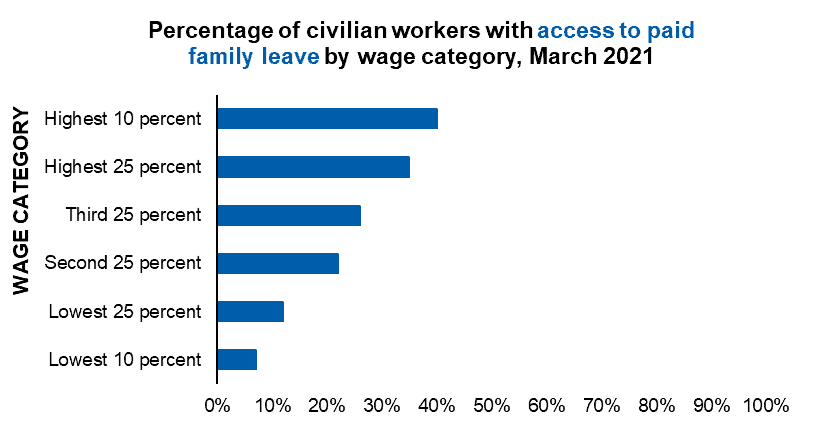
Restless nights while parents care for a newborn. Providing care for an aging parent with health needs. Recovering from your own personal illness. These are just a few examples that show a common thread: at some point all of us will need to take time away from our jobs to care for ourselves or our loved ones.
Unfortunately for most North Carolinians, our jobs don’t necessarily allow us to take that time away. This matters tremendously for our kids: paid leave makes it much more likely that they will get the care and support they need at crucial moments, and less likely they will experience abuse or neglect.
The harsh reality is that more often than not, parents are forced to choose between difficult options: take unpaid leave, take less leave than is ideal, or leave the workforce entirely, making it harder to provide for their families. Family-friendly workplace policies such as paid family and medical leave remove that difficult choice so that parents can provide for their families, both financially and emotionally.
What is paid family and medical leave?
Paid family and medical leave provides job protections and full or partial wage replacement for employees who need to take time off from work. They may use that time to welcome a new child into the family, or to take care of longer-term medical needs for themselves or a member of their family (biological or chosen).
What are the benefits of paid family and medical leave?
A growing body of research has documented the benefits of family-friendly policies like paid family and medical leave for both employees and employers. These benefits include reduced stress, improved economic stability, increased employee productivity, and improved employer recruitment and retention. Financial insecurity is a common source of parental stress, which in turn leads to a greater likelihood of child maltreatment.
Paid leave is a concrete form of support that helps families get through tough times. It’s a great example of a “policy lever” — a tool lawmakers can use to actually prevent child abuse and neglect, reducing both the harm to children, and the cost of interventions after the fact.
Paid family leave has been linked to a significant reduction in hospital admissions for Abusive Head Trauma. Abusive Head Trauma, also known as Shaken Baby Syndrome, is the leading cause of physical child abuse deaths in children under age five in the United States. Babies less than one year old are at the greatest risk of injury from Abusive Head Trauma, and it accounts for about one-third of all child maltreatment deaths.
Who has access to paid family and medical leave?
As of March 2021, between 7% and 40% of civilian workers in the U.S. had access to paid family leave. The large discrepancy can be explained by the wage categories reported by the Bureau of Labor Statistics (BLS), ranging from lowest 10% of earners to highest 10% of earners. The highest 10% of earners are most likely to have paid leave — 4 in 10 of the highest-earners get paid leave from their jobs. Among those earning least, only 7 out of 100 workers get paid leave. The lowest wage category makes $12.00/hour (or $24,960 gross salary) — arguably the group that can least afford to take unpaid leave.

New report focuses on policymakers’ ideas for preventing child maltreatment
The policy team at Prevent Child Abuse NC recently released their report “Forward with Hope: Policymaker Perspectives on Child Maltreatment Prevention in North Carolina.” The report is based on the findings of a qualitative study the team conducted to learn more about what policymakers know about child maltreatment prevention, and policies and investments that have been linked to boosting child and family well-being.
Study findings indicate that family-friendly workplace policies are widely known by policymakers, and the benefits are understood. However, the mechanism for implementing family-friendly policies such as paid family and medical leave was not as well understood or agreed upon by participants. Participants were aware of the benefits, but not sure how to balance the needs of business and employees without causing harm.
What are the concerns?
While most participants were able to readily describe the benefits of family friendly workplaces and paid leave, there were also some concerns expressed about paid leave. Common themes for concerns focused on the impact of paid leave on small businesses, the challenges some businesses face with hiring temporary replacement staff, the need for balance within policies, and a general concern about a policy being able to meet the differing and unique needs of various businesses and industries.
What is the path forward for paid leave in NC?
Policymakers had many ideas for how to move paid leave forward, primarily falling into a few overall categories. The themes for paid leave’s path forward included:
- Keeping the conversation at the forefront;
- Building momentum from the local and county level;
- Finding ways to build bridges to those who have expressed hesitation or opposition to paid leave so that they might support it; and
- Exploring a policy for state employees.
Participants across the political spectrum expressed that they believe in benefits offered by paid leave, and the differences between the major parties only became evident when discussing concerns related to the specifics of the mechanism by which a paid leave policy is implemented.
How to take action
The policy team provides a bulleted list of actions that advocates could take or focus on as they try to advance paid leave policies in North Carolina, including:
- Keeping the conversation about the importance of paid leave going publicly;
- Building local momentum by working to support counties and municipalities in passing paid leave policies;
- Working with the business community and Chambers of Commerce to identify and address their concerns with policy proposals; and
- Exploring avenues for securing expanded access to paid leave for those employed in state (and potentially other) government roles.
The good news is that there is a path forward. The policymakers that were interviewed as part of the study had an overall favorable view of paid family and medical leave.




